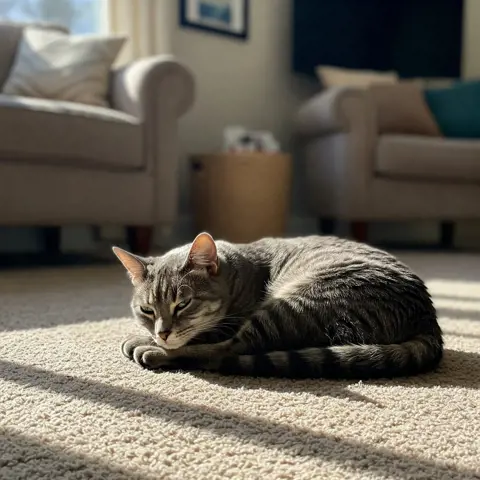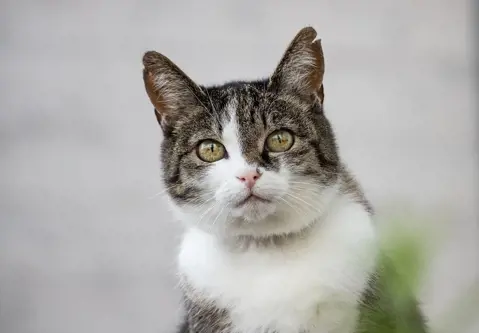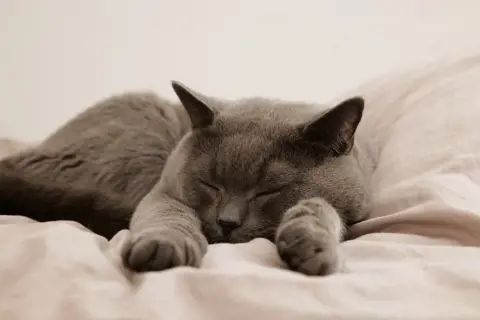10 Medical Reasons Your Cat Is Walking in Circles (And When to Worry)

In This Article
Understanding Your Cat’s BehaviorTop Medical Reasons Your Cat Might Be Walking in Circles
When to See a Veterinarian
Diagnosing the Root Cause
Treatment Options for Cats Walking in Circles
Conclusion
It might seem harmless at first, but if your cat is walking in circles, it could signal a deeper health issue. While occasional pacing might not raise alarms, repetitive or unusual circling often points to medical or neurological concerns. Conditions like ear infections, strokes, or even age-related issues in an old cat walking in circles are worth noting. If you're asking yourself, "Why is my cat pacing in circles?" it's important to act quickly and reach out to your vet. For more signs that could indicate health problems, you might want to read Cats Sticking Their Tongue Out – Should You Be Worried?, as similar subtle behaviors can also hint at underlying concerns. Understanding these signs can help keep your feline friend healthy and safe.
Understanding Your Cat’s Behavior
Understanding your cat's behavior can feel like solving a riddle at times. Cats are complex creatures with unique quirks and habits. While it's normal for cats to exhibit certain behaviors like scratching furniture or pouncing on shadows, changes in behavior, especially sudden ones like walking in circles, can be cause for concern. Whether it's an old cat walking in circles or a younger feline showing strange patterns, it's crucial to pay attention.
Normal Cat Behaviors You Should Expect

Cats are known for their predictable routines, but they're also notorious for their peculiarities. Here are some behaviors that are usually considered normal:
- ScratchingIt's no secret that cats love to scratch. They do it to sharpen their claws, mark their territory, or even for fun. If you’ve noticed your cat scratching near their food bowl, it may be worth exploring more about the reasons behind why cats scratch around their food bowl.
- GroomingCats spend a large portion of their day grooming themselves, keeping their fur clean and free of debris. This is a vital part of their routine.
- Hunting InstinctsWhether it's stalking a toy mouse or the red beam from a laser pointer, cats love to exercise their inborn hunting reflex.
Watching your cat engage in these activities is a comforting sign of their vibrant and happy personality. But what happens when their behavior deviates from the norm?
Red Flags: When Cat Behavior Signals Trouble
Behavioral changes can sometimes be subtle, so spotting them early can make a huge difference. If your cat is pacing or exhibiting repetitive actions such as walking in circles, it's essential to determine if there's an underlying issue. Patterns of concern include:
- Neurological Symptoms A cat walking in circles neurologically might be experiencing issues such as vestibular disease—a condition that disrupts their sense of balance. This often happens in older cats, so if you've noticed an old cat walking in circles, it may indicate age-related conditions or something more serious.
- Disorientation or ConfusionIf your cat starts pacing and seems unsure of its surroundings, it could point to disorientation, which might occur due to brain health concerns or even dehydration.
- Physical DistressSometimes walking in circles reflects physical pain or discomfort. Cats are notorious for hiding pain, so behavioral changes are often the first signs something is wrong.
Awareness of what's normal and what isn't helps you stay on top of your cat's well-being. And when something feels off, it's always better to reach out to a veterinarian sooner rather than later. After all, sudden changes like circling could point to serious issues requiring prompt attention.
By keeping a close eye on their habits, you ensure your feline friend stays healthy and happy.
Top Medical Reasons Your Cat Might Be Walking in Circles

If you've noticed your cat walking in circles, it can be a distressing sight that leaves you full of worry. This behavior can stem from simple causes or be a sign of more significant medical conditions. Below, we've outlined the top medical reasons behind this behavior, helping you understand what's normal and what might require a trip to the vet.
1. Ear Infections
An ear infection, especially in the inner ear, can throw your cat's balance completely out of whack. Cats rely on their inner ear to maintain equilibrium, so when it's inflamed, they may begin to walk in circles. Other symptoms include head shaking, ear scratching, and tilting their head to one side. Treatment usually involves cleaning the ear canal and antibiotics prescribed by your veterinarian. Don't hesitate to seek help; untreated infections can worsen and cause further complications.
2. Neurological Disorders
Neurological conditions, like vestibular syndrome, are common causes of a cat walking in circles neurologically. This disorder affects the vestibular system, which controls balance and coordination. You'll often see additional signs such as uneven pupils, head tilting, or wobbliness. If you suspect a neurological issue, consult your vet for a thorough examination. Prompt diagnosis can help manage symptoms and improve your cat's quality of life.
3. Head Trauma
Blows to the head or accidents that impact a cat's brain can lead to disorientation and pacing in circles. It could happen after a fall, a car accident, or even rough play gone wrong. If you notice circling behavior after a known injury, watch for other signs of trauma like lethargy, seizures, or difficulty walking. Immediate veterinary care is vital for assessment and to prevent worsening conditions.
4. Stroke
While strokes are less common in cats than in humans, they can occur and often trigger symptoms like walking in circles. A stroke disrupts blood flow to the brain, leading to disorientation, loss of balance, and sometimes partial paralysis. If you're asking yourself, "Why is my cat pacing in circles?" alongside these other symptoms, treat it as a medical emergency and see your veterinarian immediately.
5. Brain Tumors
Although rare, brain tumors can force a cat to walk in circles due to pressure on areas of the brain that control movement and balance. Other symptoms may include vision loss, seizures, and personality changes. Advanced imaging, such as MRI or CT scans, are often necessary for diagnosis. Treatment options vary but may include surgery, radiation therapy, or medication to manage symptoms.
6. Aging and Cognitive Dysfunction
For older cats, circling can sometimes indicate cognitive dysfunction, a feline equivalent of Alzheimer's disease. Aging cats may become disoriented or confused, leading to unusual habits like pacing or walking in circles. If you've noticed an old cat walking in circles more frequently, consult your vet about supportive treatments that could include supplements or changes in diet to support brain health.
7. Poisoning or Toxicity
Toxic substances, including certain household plants, chemicals, or even some human medications, can cause neurological symptoms like circling. You'll likely notice additional signs like vomiting, drooling, or seizures. If you suspect poisoning, time is critical—contact your veterinarian or an animal poison control center immediately.
8. Parasites Affecting the Brain
In rare cases, certain parasites can infect a cat’s brain, leading to inflammation and strange behaviors like walking in circles. Toxoplasmosis or other parasitic diseases may be the culprit, often accompanied by lethargy, fever, and other neurological symptoms. Diagnosing and treating these conditions typically involves blood tests and antiparasitic medications.
9. Vestibular Syndrome
Vestibular syndrome is one of the most common neurological diagnoses in cats experiencing balance issues. This condition can cause a cat to tilt its head, stumble, and yes, to walk in circles. While vestibular syndrome may look alarming, it’s often temporary and caused by inner ear inflammation or infection. Keep an eye on other signs like nausea or rapid eye movement. Treatment focuses on addressing the underlying issue, coupled with supportive care to ease symptoms, making it a top reason for a cat walking in circles neurologically.
10. Pain-Related Behaviors
For some cats, chronic pain or discomfort might lead to odd behaviors, including pacing or circling. Cats are experts at hiding pain, so you might not immediately connect their circling to an internal issue. Whether it's arthritis, dental pain, or an undiagnosed injury, keeping an eye on their behavior and consulting with a vet can help determine the cause and bring them relief.
When to See a Veterinarian
If your cat is walking in circles, it’s crucial to know when to involve a veterinarian. While some behaviors may stem from minor or temporary issues, repeated circling behavior often points to serious underlying conditions. Not all symptoms are created equal, so understanding red flags and what demands immediate attention can make all the difference in keeping your feline friend safe.
Repeated Circling Patterns
Cats naturally explore their surroundings, but consistent pacing, circling, or an inability to walk in a straight line is not normal behavior. If you find your cat persistently walking in circles without any apparent cause, it could indicate problems such as ear infections, neurological diseases, or even brain tumors. Early intervention by a veterinarian ensures the best chance of diagnosing and treating the root cause.
Disorientation and Neurological Symptoms
Is your cat appearing confused or disoriented while pacing? Disorientation is a strong indicator of possible neurological impairment. Watch for accompanying symptoms such as head tilting, uneven pupils, or an abnormal gait. These signs should never be ignored, as they often suggest serious health concerns that might require advanced diagnostic testing.
Accompanying Symptoms of Concern
If circling is paired with other unusual behaviors or symptoms, act quickly. Red flags include:
- Vomiting or DiarrheaSudden changes in digestion combined with circling could signal poisoning or systemic illness.
- SeizuresIf your cat has seizures—even brief ones—it’s vital to consult a veterinarian immediately.
- LethargyExtreme tiredness alongside circling might indicate underlying conditions like infections, organ failure, or dehydration.
- Appetite Loss or Weight ChangesA cat that suddenly exhibits circling and refuses food might face a serious systemic health issue.
Emergency Situations
Some symptoms paired with circling constitute medical emergencies. These include severe head trauma, poisoning, or difficulty breathing. If your cat has been in an accident or comes into contact with known toxins, circle and pace patterns might develop quickly. In these situations, do not wait—get to your vet or an animal emergency clinic immediately.
Your pet relies on you to catch these alarming signals. If you're ever in doubt, err on the side of caution and schedule a veterinary appointment. Early detection could be life-saving.
Diagnosing the Root Cause

Pinpointing why your cat is walking in circles is essential to addressing the behavior effectively. This process involves several diagnostic steps, focusing on assessing the overall health, examining neurological function, and utilizing advanced tools to uncover hidden medical conditions. A thorough diagnosis can provide clarity and direction for treatment, ensuring your feline companion gets the care they need.
Physical Examination
A physical examination is the cornerstone of identifying health issues in cats. During this checkup, the veterinarian will evaluate your cat’s general condition, including their weight, hydration status, and physical responsiveness. They will carefully inspect the cat’s ears, as issues such as infections, mites, or foreign objects could easily explain circling behaviors. Injuries, such as head trauma or even undiscovered wounds, are also assessed during this step.
Other aspects of the examination might include:
- Checking for signs of painCats excel at masking discomfort, but a detailed physical assessment can reveal hidden injuries or soreness.
- Observing mobility and stabilityWatching how your cat moves aids in determining if their balance or coordination is impaired.
- Inspecting the eyesUneven pupil size or unexplained redness could suggest neurological problems or trauma.
The physical exam is critical, as it often uncovers obvious symptoms that can either confirm or rule out certain causes.
Neurological Assessments
If no immediate external causes are found, the next step often involves a neurological evaluation. Neurological tests focus on how well your cat’s brain, spinal cord, and nerves are working together to maintain balance and coordination. This part of the diagnosis helps detect more hidden issues, like vestibular syndrome or brain disorders.
A typical neurological assessment may include:
- Reflex testsSimple tests to evaluate response times in the legs or tail, indicating how well neural pathways are functioning.
- Postural adjustmentsThe vet may observe how your cat naturally holds themselves and reacts to being moved, determining if their posture is affected by a neurological problem.
- Gait analysisWatching how your cat walks is an essential diagnostic tool. For example, circling to one side might indicate a localized brain issue.
These tests provide valuable insights and can highlight problems that merit further investigation through imaging or additional diagnostics.
Advanced Imaging and Blood Tests
When physical and neurological exams point to potential underlying conditions but lack definitive answers, more advanced tools come into play. Imaging technologies such as MRI and CT scans are instrumental in visualizing the brain and inner structures to uncover abnormalities like tumors, strokes, or infections. These scans give an in-depth look that is otherwise impossible.
Additionally, blood tests may be conducted to screen for infections, toxoplasmosis, or other metabolic disorders that could impact your cat’s behavior. Common findings might include:
- Inflammation markersSigns of infection or internal swelling.
- Nutritional imbalancesDeficiencies or excesses in essential vitamins and minerals.
- Toxin exposureIndicators of poisoning or harmful substance ingestion.
Together, imaging results and lab work help paint a highly detailed picture of your cat’s condition, guiding an accurate diagnosis. These tools are often crucial in pinpointing the root cause, especially in cases where symptoms are complex or overlapping.
By taking a structured, step-by-step approach to investigation, veterinarians maximize the chances of identifying the exact issue causing your cat to walk in circles.
Treatment Options for Cats Walking in Circles

If your cat has started walking in circles, treatment options will depend on the underlying cause behind this behavior. Once your veterinarian has conducted a thorough examination, they may suggest medications, surgical procedures, or even long-term care strategies to help your cat recover and regain their quality of life. Below are some of the common pathways veterinarians may follow while addressing this issue.
Medication and Antibiotics
For cats walking in circles due to infections or inflammation, medications are often the first line of defense. Inner ear infections, a leading cause of balance issues, can frequently be resolved through prescribed antibiotics and anti-inflammatory drugs. These medications not only treat the infection but also alleviate discomfort, helping your cat regain their normal behavior.
For example, your vet may recommend oral antibiotics for bacterial infections or antifungal medications if the issue stems from a fungal cause. Topical ear drops are also commonly used for localized issues within the ear canal. It's important to follow the full course of treatment as prescribed, even if your cat seems to feel better in a few days. Skipping doses could allow the infection to return, potentially leading to more severe complications.
Other neurological conditions, such as vestibular syndrome, may require medications to manage symptoms like dizziness, nausea, or vomiting. If your cat's circling behavior stems from a condition like cognitive dysfunction, your vet might recommend dietary supplements alongside medications aimed at boosting brain health.
Surgical Interventions
In more severe cases, surgical intervention may become necessary. Tumors, head trauma, or specific structural issues within your cat's ears or brain are examples of conditions where surgery could offer relief. For instance, if a brain tumor is detected, procedures to remove or reduce its size may be recommended, particularly if it’s pressing on areas responsible for balance and movement.
Similarly, inner ear surgeries may be performed to remove polyps or other obstructions impairing your cat’s equilibrium. While surgery for cats often feels daunting, modern veterinary medicine offers advanced techniques designed to minimize risk and recovery time.
Your vet will only suggest surgery when absolutely needed and will provide a detailed explanation of the risks, benefits, and expected outcomes. Post-surgery care, including medications and check-ups, ensures a smoother recovery process.
Supportive and Long-Term Care
For chronic conditions such as cognitive dysfunction syndrome (akin to Alzheimer’s in humans), there may not be a straightforward cure, but that doesn’t mean your cat can’t enjoy a happy and comfortable life. Supportive care plays a huge role in managing these cases.
Your vet might recommend lifestyle changes such as creating a stress-free environment for your cat by offering consistent routines, enriching experiences like puzzle toys, and calming pheromone diffusers. Specialized diets rich in antioxidants may also be suggested to support overall neurological health.
Certain medications, such as those designed to enhance circulation or improve neural function, can be prescribed to help older cats cope better with symptoms. Your vet might also recommend regular follow-up visits to monitor progression and make adjustments to treatment plans. Cats showing signs of confusion or disorientation can benefit from a structured environment and plenty of love and patience from their owners.
By addressing both the immediate and long-term needs of your cat, you can help ensure their well-being while managing the underlying causes of their circling behavior. Always work closely with your veterinarian to tailor these treatment options to your cat’s specific condition. This comprehensive approach gives your feline friend the best chance at recovery or symptom management, depending on their diagnosis.
Conclusion
Taking swift action when your cat is walking in circles is essential for their well-being. This behavior often signals serious underlying health concerns, from ear infections to neurological issues, that require prompt veterinary attention. Ignoring the signs can lead to heightened complications, impacting your cat’s comfort and quality of life.
Your cat’s health depends on your vigilance. If you observe persistent circling, unusual symptoms, or changes in their behavior, schedule an appointment with your vet as soon as possible. Early intervention not only eases your worry but also gives your feline friend the best chance at recovery or effective symptom management. Always trust your instincts and act quickly—it could make all the difference for your pet.
Frequently Asked Questions
- Why is my cat walking in circles all of a sudden?
- Sudden circling can be a sign of a serious underlying issue, such as vestibular disease, head trauma, or a neurological problem. It’s important to contact your veterinarian right away to determine the cause.
- Could ear infections make my cat walk in circles?
- Yes. Inner or middle ear infections can impact your cat’s balance, causing them to move in circles or appear disoriented. If you notice symptoms like head shaking, ear discharge, or loss of balance, seek veterinary care promptly.
- Can brain tumors cause my cat to walk in circles?
- Unfortunately, yes. Brain tumors may lead to behavioral changes like circling, along with symptoms such as lethargy, seizures, or vision problems. Your vet can help with diagnostic imaging to confirm or rule this out.
- Is my cat circling because they’re confused?
- Confusion and disorientation in older cats, often due to cognitive dysfunction syndrome (similar to dementia), can make them circle or pace. A vet can offer guidance on managing these age-related changes.
- Could a stroke be why my cat is circling?
- Strokes or other vascular events in the brain may cause sudden circling, loss of coordination, and weakness. Cats displaying these symptoms need immediate veterinary attention.
- Do parasitic infections cause circling?
- Yes, parasites like toxoplasmosis or some worms can sometimes lead to neurological symptoms, including circling. Speak to your vet about diagnostic testing and potential treatments.
- Can trauma or head injuries make cats walk in circles?
- Yes, head injuries can disrupt your cat’s sense of balance or cause neurological issues. If you suspect an injury, even if it seems minor, have your vet evaluate them as soon as possible.
- Is circling behavior linked to vision problems?
- Yes. Cats with impaired vision or blindness might walk in circles to orient themselves or as a result of brain damage linked to eyesight loss. Your vet can examine their eyes and brain function.
- Could toxins or poisoning cause my cat to walk in circles?
- Toxins, like certain plants, chemicals, or human medications, can affect your cat’s nervous system, leading to circling, tremors, or seizures. If you suspect poisoning, seek emergency care immediately.
- Should I be worried if my cat is walking in circles but seems fine otherwise?
- Even if your cat seems otherwise healthy, circling is rarely normal. It can be an early sign of a problem you may not fully see yet. Don’t wait—schedule a vet visit to address this behavior.
CatsLib.com relies on trusted, high-quality sources, including peer-reviewed research, to back the information in its articles. We regularly review and update our content to ensure it remains accurate and reliable.
If you have concerns about your pet's health or any medical questions, we highly recommend consulting a qualified veterinarian. The information on this site is for general informational purposes only and should not be used as a substitute for professional advice, diagnosis, or treatment.
How We Ensure Accuracy
At CatsLib, we take the accuracy of the information we provide very seriously. Our content is created and reviewed by experts to ensure that every piece of advice is not only helpful but also based on the latest veterinary research. Here’s how we make sure the information you read is reliable:
- ✔ Content reviewed by certified experts
- ✔ Based on up-to-date veterinary research
- ✔ Reviewed regularly for relevance and accuracy
Recent Articles

Why Are Siamese Cats Cross Eyed? Genetics, Health, and Care Guide

Do Ragdoll Cats Shed a Lot? Seasonal Tips to Manage Fur and Keep Your Home Clean

10 Medical Reasons Your Cat Is Walking in Circles – Signs You Should Never Ignore

Why Does Your Cat Scratch Around Its Food Bowl? Top Reasons and Simple Solutions

